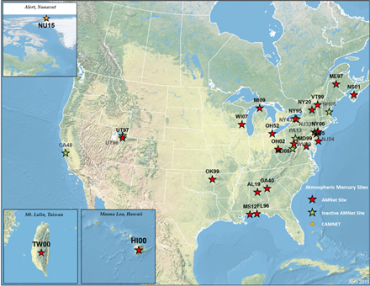Air Resources Laboratory Contributes to Improve National Mercury Measurements
September, 2015
September, 2015
ARL is partnering with the National Atmospheric Deposition Program (NADP) to host an international mercury measurement workshop September 22- 24, 2015 at the NOAA Center for Weather and Climate Prediction in College Park, MD. The overall goal of the workshop is to exchange information and results of recent research characterizing possible measurement biases and artifacts in the monitoring methodology used by the U.S. Atmospheric Mercury Network (AMNet)
to host an international mercury measurement workshop September 22- 24, 2015 at the NOAA Center for Weather and Climate Prediction in College Park, MD. The overall goal of the workshop is to exchange information and results of recent research characterizing possible measurement biases and artifacts in the monitoring methodology used by the U.S. Atmospheric Mercury Network (AMNet) , a network that is part of the NADP. Approximately twenty-five mercury measurement specialists from the private sector, state agencies, universities, and foreign national program offices will come together to produce a concrete set of recommendations for the NADP regarding the possible modification of the measurement techniques and/or of the Standard Operating Protocols (SOPs).
, a network that is part of the NADP. Approximately twenty-five mercury measurement specialists from the private sector, state agencies, universities, and foreign national program offices will come together to produce a concrete set of recommendations for the NADP regarding the possible modification of the measurement techniques and/or of the Standard Operating Protocols (SOPs).
Background: The AMNet was established in 2009 for the purpose of measuring atmospheric mercury fractions which contribute to dry and total mercury deposition. It’s an intensively-operated counterpart to the NADP Mercury Deposition Network, which was established in 1996 to monitor mercury in precipitation. There are currently 20 active AMNet sites in the U.S., and three of these are flagship sites (Grand Bay NERR, MS; Beltsville, MD; and Mauna Loa Observatory, HI) operated by ARL. Recent research suggests that measurement artifacts and biases can arise in the monitoring of certain mercury fractions. Since AMNet’s establishment, there has been no comprehensive survey and assessment of measurement inaccuracies, nor an adjustment of the SOPs to eliminate or mitigate them. This workshop represents the first step toward addressing these important issues and recommending solutions. NOAA, via ARL, has been a cooperating federal agency partner in the NADP since the early 1990s.

Significance: Mercury is a neurotoxin that persists in the environment for long periods by cycling between the air, water, and soil in different chemical forms. The majority of mercury released to the environment is into the atmosphere. Mercury eventually deposits to watersheds and receiving waters where it can be converted to methylmercury, the most highly toxic form. Humans are exposed to this mercury primarily through consuming contaminated fish and other aquatic organisms. The primary health effect of methylmercury is impaired neurological development in fetuses, infants, and children. As a result, fish consumption advisories due to mercury contamination are widespread throughout the United States. This workshop will lead to the development of improved atmospheric mercury measurement methods and protocols, which in turn improve atmospheric models and allow for a more comprehensive study of the global biogeochemical cycle of mercury. The NADP AMNet provides critical information for policy makers and regulators and supports the EPA and NOAA mandate under the 1990 Clean Air Act Amendments.